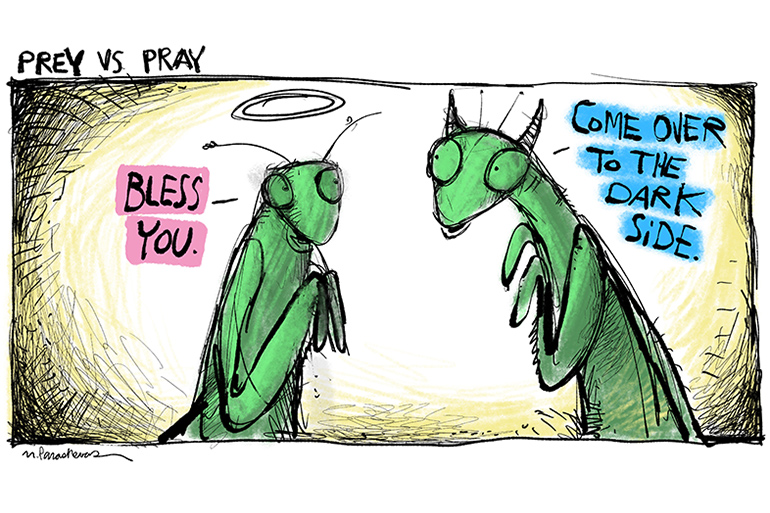Evil Mantis: Invasive Species Kills & Eats Hamptons Praying Mantis

We share the fabulous Hamptons with many other sorts of creatures. Some we have decided are deserving of protection. A bird known as the least tern is one. Eagles are another. And piping plovers and osprey are still others. From the seas we are urged to protect striped bass, whales and sharks. And then there are the creatures on land. One particular one is the praying mantis.
It’s tan or green in color and about three inches long, has long legs that can fold and unfold and long arms that can fold up into what appears to be prayer. Often praying mantises sit perfectly still, an activity that seems to further suggest their religious concern, but which others say they do so as to blend in with the foliage near where they sit so as to not be seen.
This summer saw the arrival of a new kind of mantis, though. It has not yet been decided whether to offer protection or consider it an intruder. The balance seems to be shifting from protecting to swatting. These new arrivals are much more aggressive than the other kind of mantis.
A problem is they look very much like praying mantises. So if one is to be protected and the other not protected, close identification is in order.
The two mantises, the praying mantis and they preying mantis, have only two features that distinguish one from the other. And the fact that the two kinds are rarely seen together makes this even more difficult. The preying mantis is a quarter of an inch larger than a praying mantis. It’s a small thing, but if you carry a tape measure you’ll be able to confirm which it is. I might add that the reason you only rarely see these two mantises around together is because preying mantises eat praying mantises on sight. Praying mantises offer no resistance. If anything, they can be seen turning the other cheek. So if you see both of the species together you can be sure that one is about to attack the other. You might move fast if you see that. Swat the larger one (if death is decided to be the order of the day).
The second difference between the two species is also a small thing. Preying mantises, unlike their more peaceful cousins, have long, sticky, black tongues that unroll from the back of their throats when they open their mouths briefly to eat. The tongue is forked at the end. The unrolling—18 inches!—and subsequent retraction of the tongue have been photographed and can be seen in slow motion on YouTube.
With the mouth closed, however, the forked end of this tongue—either one or both tips—still sticks out a tiny bit. It doesn’t fully retract. And you can see it. Scientists believe this failure to fully retract is a genetic flaw that might be corrected in the future as the creatures continue to mate, which they do three times a day. A very alarming and disgusting sight, by the way.
Of course, a sticky tongue 18 inches long will not hurt you. If you appear to threaten a preying mantis, however, the tongue will lash out and stick to your leg or your clothes so if you try to run away, you take the preying mantis and his sticky tongue with you. Pulling him off is no fun. But it is possible. And from the preying mantis’s perspective, he’s just in a new place to behave badly like this—just as soon as he completes a retraction.
The sticky tongue, of course, is death to small bugs, which is the other thing that preying mantises eat. One second they are here, the next they are gone. As for the praying mantis, death is more awful. The preying mantis tongue strikes numerous times, each time disassembling a part of the praying mantis. It is not pretty, seems malevolent and is particularly offensive to members of the cloth.
No one knows how the first preying mantis came to the Hamptons. Some say the female of the species arrived pregnant and perched in the leaves of an exotic tree brought by a landscaping firm here from Japan, from the island of Okinawa, Japan where they are especially abundant.

But no one knows for sure.
One thing to look out for—all the authorities are on the lookout for this—is the single nest somewhere in the woods of the Hamptons where the preying mantises are hatched. Late at night, the Queen Preying Mantis, who in one week grows to an enormous size, stands up in her nest to her full height of 36 feet and scans the landscape over the trees in every direction to determine the next day’s target for her minions.
The Queen has never been seen doing this in the Hamptons, but in Okinawa she has. She rises to look around above the jungle canopy for a full 15 minutes before lying back down. Unfortunately, 15 minutes has never been enough time to find her, as she does it only once a night and it’s never at the same time.
Anyway, that’s enough about mantises, either praying or preying.



